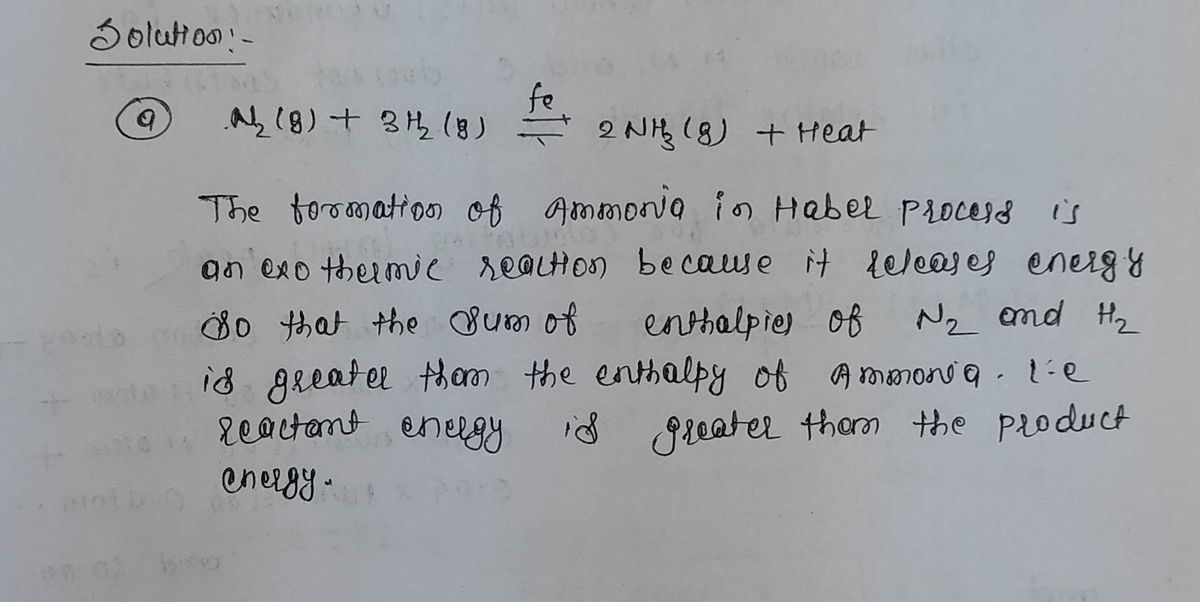2. Ammonia is produced by the Haber process, in which nitrogen and hydrogen are reacted directly using an iron mesh impregnated with oxides as a catalyst. For the reaction N2(g) + 3H2(g)= 2NH3(g) equilibrium constant (Kp values) as a function of temperature are 300 °С, 4.34 х 10-3 500 °С, 1.45 х 10-5 600 °С, 2.25 х 10-6 (a) Is the reaction exothermic or endothermic? Explain why. (b) Calculate AH° from the data using the van't Hoff equation: (K2 In ΔΗ rxn T2. Is the sign of AH° in your answer consistent with your answer for (a)?
2. Ammonia is produced by the Haber process, in which nitrogen and hydrogen are reacted directly using an iron mesh impregnated with oxides as a catalyst. For the reaction N2(g) + 3H2(g)= 2NH3(g) equilibrium constant (Kp values) as a function of temperature are 300 °С, 4.34 х 10-3 500 °С, 1.45 х 10-5 600 °С, 2.25 х 10-6 (a) Is the reaction exothermic or endothermic? Explain why. (b) Calculate AH° from the data using the van't Hoff equation: (K2 In ΔΗ rxn T2. Is the sign of AH° in your answer consistent with your answer for (a)?
Chemistry
10th Edition
ISBN:9781305957404
Author:Steven S. Zumdahl, Susan A. Zumdahl, Donald J. DeCoste
Publisher:Steven S. Zumdahl, Susan A. Zumdahl, Donald J. DeCoste
Chapter1: Chemical Foundations
Section: Chapter Questions
Problem 1RQ: Define and explain the differences between the following terms. a. law and theory b. theory and...
Related questions
Question

Transcribed Image Text:2. Ammonia is produced by the Haber process, in which nitrogen and hydrogen are reacted
directly using an iron mesh impregnated with oxides as a catalyst. For the reaction
N2(g) + 3H2(g)= 2NH3(g)
equilibrium constant (Kp values) as a function of temperature are
300 °С, 4.34 х 10-3
500 °C, 1.45 х 10-5
600 °C, 2.25 х 10-6
(a) Is the reaction exothermic or endothermic? Explain why.
(b) Calculate AH° from the data using the van't Hoff equation:
AHrxn
K2
In
\K.
R
\71
T2
Is the sign of AH° in your answer consistent with your answer for (a)?
Expert Solution
Step 1

Trending now
This is a popular solution!
Step by step
Solved in 3 steps with 3 images

Knowledge Booster
Learn more about
Need a deep-dive on the concept behind this application? Look no further. Learn more about this topic, chemistry and related others by exploring similar questions and additional content below.Recommended textbooks for you

Chemistry
Chemistry
ISBN:
9781305957404
Author:
Steven S. Zumdahl, Susan A. Zumdahl, Donald J. DeCoste
Publisher:
Cengage Learning

Chemistry
Chemistry
ISBN:
9781259911156
Author:
Raymond Chang Dr., Jason Overby Professor
Publisher:
McGraw-Hill Education

Principles of Instrumental Analysis
Chemistry
ISBN:
9781305577213
Author:
Douglas A. Skoog, F. James Holler, Stanley R. Crouch
Publisher:
Cengage Learning

Chemistry
Chemistry
ISBN:
9781305957404
Author:
Steven S. Zumdahl, Susan A. Zumdahl, Donald J. DeCoste
Publisher:
Cengage Learning

Chemistry
Chemistry
ISBN:
9781259911156
Author:
Raymond Chang Dr., Jason Overby Professor
Publisher:
McGraw-Hill Education

Principles of Instrumental Analysis
Chemistry
ISBN:
9781305577213
Author:
Douglas A. Skoog, F. James Holler, Stanley R. Crouch
Publisher:
Cengage Learning

Organic Chemistry
Chemistry
ISBN:
9780078021558
Author:
Janice Gorzynski Smith Dr.
Publisher:
McGraw-Hill Education

Chemistry: Principles and Reactions
Chemistry
ISBN:
9781305079373
Author:
William L. Masterton, Cecile N. Hurley
Publisher:
Cengage Learning

Elementary Principles of Chemical Processes, Bind…
Chemistry
ISBN:
9781118431221
Author:
Richard M. Felder, Ronald W. Rousseau, Lisa G. Bullard
Publisher:
WILEY